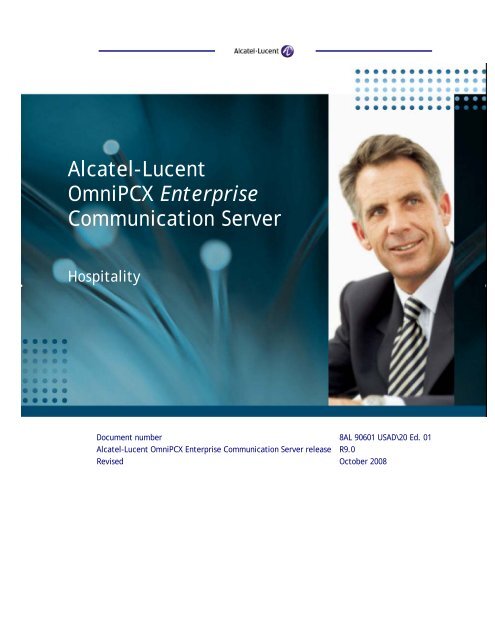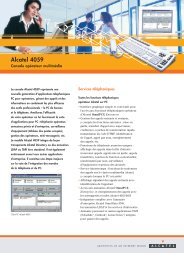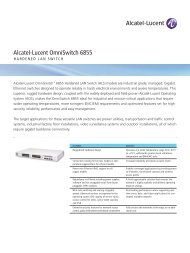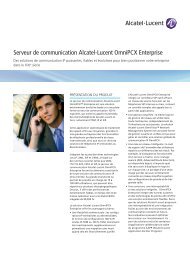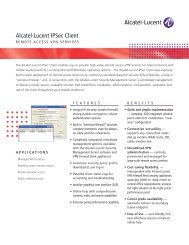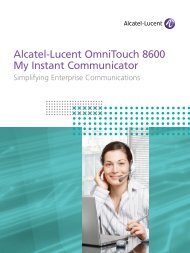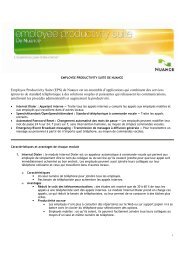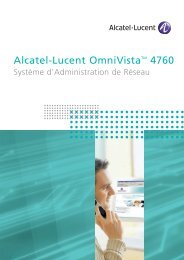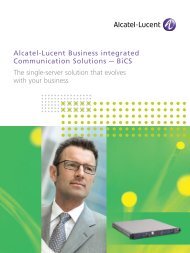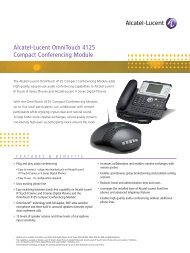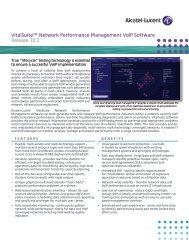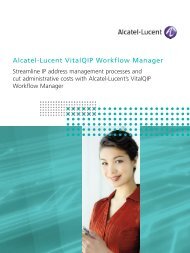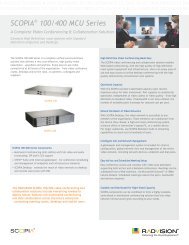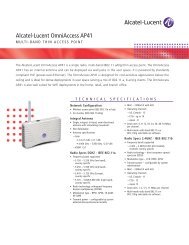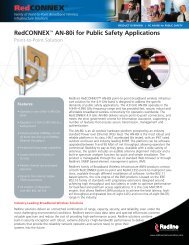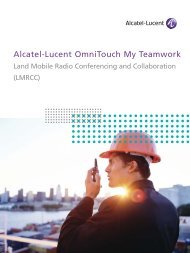Alcatel-Lucent OmniPCX Enterprise ... - SSP Telecom Inc.
Alcatel-Lucent OmniPCX Enterprise ... - SSP Telecom Inc.
Alcatel-Lucent OmniPCX Enterprise ... - SSP Telecom Inc.
You also want an ePaper? Increase the reach of your titles
YUMPU automatically turns print PDFs into web optimized ePapers that Google loves.
<strong>Alcatel</strong>-<strong>Lucent</strong><br />
<strong>OmniPCX</strong> <strong>Enterprise</strong><br />
Communication Server<br />
Hospitality<br />
Document number 8AL 90601 USAD\20 Ed. 01<br />
<strong>Alcatel</strong>-<strong>Lucent</strong> <strong>OmniPCX</strong> <strong>Enterprise</strong> Communication Server release R9.0<br />
Revised October 2008
Copyright © <strong>Alcatel</strong>-<strong>Lucent</strong> 2000–2008. All rights reserved.<br />
Passing on and copying of this document, use and communication of its contents not permitted<br />
without written authorization from <strong>Alcatel</strong>-<strong>Lucent</strong>.<br />
Notice<br />
While reasonable effort is made to ensure that the information in this document is complete<br />
and accurate at the time of printing, we can not assume responsibility for any errors. Changes<br />
and/or corrections to the information contained in this document may be incorporated into<br />
future issues.<br />
This document introduces the <strong>Alcatel</strong>-<strong>Lucent</strong> <strong>OmniPCX</strong> <strong>Enterprise</strong> Communication Server, its<br />
products and features. All documents associated to this introduction cover most of the aspects<br />
for designing offers based on current manufacturers and business partner agreements.<br />
They include introductory explanations to position the offer in relation to client needs. References<br />
to in-depth documentation are indicated to direct you to product descriptions or<br />
product sites.<br />
Who Should Use this Document?<br />
As an introductory offer, this document can be used by <strong>Alcatel</strong>-<strong>Lucent</strong> vendors, clients, partners<br />
and associates involved with the implementation of <strong>Alcatel</strong>-<strong>Lucent</strong> PCX systems.<br />
Terms and Abbreviations Used in this Document<br />
Terms and abbreviations specific to each subject may be noted in individual glossaries.<br />
A general overview document is available in this documentation set.<br />
Changes Summary<br />
The Standard Offer document set is based on a specified release and each document can contain<br />
a “What’s new?” chapter to indicate product modifications associated with the release.
Contents<br />
1 Overview............................................................................................. 9<br />
1.1 <strong>Alcatel</strong>-<strong>Lucent</strong> Hospital Link .................................................................9<br />
2 Guest Services ..................................................................................... 11<br />
2.1 Direct Outward Dialing (DOD) .............................................................. 11<br />
2.2 Direct Inward Dialing (DID) ................................................................. 11<br />
2.3 Cyclical DID.................................................................................... 11<br />
2.4 Speed Dialing.................................................................................. 11<br />
2.5 Redial Key ..................................................................................... 11<br />
2.6 Unanswered Calls ............................................................................ 12<br />
2.7 Call Forwarding............................................................................... 12<br />
2.8 Do Not Disturb (DND) ........................................................................ 12<br />
2.9 Wake-up or Reminder Calls................................................................. 13<br />
2.10 Voice Mail Services........................................................................... 13<br />
2.10.1 Check-in/Checkout.................................................................... 13<br />
2.10.2 Mailbox .................................................................................. 13<br />
2.10.3 Room Move ............................................................................. 14<br />
2.10.4 Deferred Mailbox Deletion ........................................................... 14<br />
2.11 Call Restriction ............................................................................... 14<br />
2.12 Message on Free or Busy Phone............................................................ 15<br />
2.13 Privacy ......................................................................................... 15<br />
2.14 Dual-line, Consultation Call, Broker Call, Transfer, and Conference ............... 15<br />
2.15 Room Move .................................................................................... 15<br />
2.16 Partial Checkout.............................................................................. 16<br />
2.17 Multiple Languages........................................................................... 16<br />
2.18 House Phone .................................................................................. 16<br />
3 Front office services ............................................................................. 17<br />
3.1 Individual Check-in........................................................................... 17<br />
3.2 Group Check-in ............................................................................... 17
3.3 Guest Directory............................................................................... 18<br />
3.4 Room Service.................................................................................. 18<br />
3.5 Room Management........................................................................... 18<br />
3.6 Charging ....................................................................................... 19<br />
3.6.1 Charging by Time ...................................................................... 19<br />
3.6.2 Charging by Units (Pulses) ........................................................... 19<br />
3.7 Prepayment (Deposit Mode) ................................................................ 20<br />
3.8 Multiple Carriers.............................................................................. 20<br />
3.9 Billing........................................................................................... 21<br />
3.9.1 Storage .................................................................................. 21<br />
3.9.2 Printing Guest Records ............................................................... 21<br />
3.9.3 Printing Staff Phone Records ........................................................ 21<br />
3.9.4 Dialed Number Mask .................................................................. 22<br />
3.9.5 Specific Online Printing .............................................................. 22<br />
3.9.6 Transfer of Call (Outgoing Call) to a Guest ....................................... 22<br />
3.9.7 Record Transfer........................................................................ 22<br />
3.9.8 Pre-assignment Record ............................................................... 22<br />
3.9.9 Itemized Bills........................................................................... 22<br />
3.10 Dynamic Suites................................................................................ 23<br />
3.10.1 Making Calls ............................................................................ 23<br />
3.10.2 Receiving Calls ......................................................................... 23<br />
3.10.3 Do Not Disturb (DND) ................................................................. 23<br />
3.10.4 Wake-up................................................................................. 23<br />
3.10.5 Dual-line, Transfer, and Conference ............................................... 23<br />
3.10.6 Voice Mail ............................................................................... 23<br />
3.10.7 Room Phones ........................................................................... 24<br />
3.11 Guest Departure.............................................................................. 24<br />
3.11.1 Individual Checkout ................................................................... 24<br />
3.11.2 Group Checkout........................................................................ 25<br />
3.12 Night Audit .................................................................................... 25<br />
3.13 VIP calls ........................................................................................ 25<br />
3.14 Access to Management Application ....................................................... 25
3.15 <strong>Alcatel</strong>-<strong>Lucent</strong> Hotel Link (AHL) ........................................................... 25<br />
3.16 Networking .................................................................................... 26
1 Overview<br />
The <strong>OmniPCX</strong> <strong>Enterprise</strong> Communication Server hospitality software is an integrated application<br />
providing a consistent group of features designed to address the following needs:<br />
• Handling guest arrivals and departures<br />
• Handling group arrivals and departures<br />
• Management of wake-up calls<br />
• Management of guest voice messages<br />
• Dynamic suites configurations (in guest-based configuration)<br />
• Billing of calls from rooms<br />
• Real-time tracking of guest telephone credit (deposit)<br />
• Verification and tracking of room status<br />
• Management of room service<br />
• Management of waiting messages<br />
The <strong>OmniPCX</strong> <strong>Enterprise</strong> Communication Server hospitality software can also work in association<br />
with a hospitality property management system (PMS) with the <strong>Alcatel</strong>-<strong>Lucent</strong> hospitality<br />
link (AHL) to satisfy the following needs:<br />
<br />
<br />
Dialing plans adaptable to the hotel configuration, such as matching phone numbers to<br />
room numbers.<br />
Different and separate outgoing trunk groups for the room phones and the administration<br />
phones.<br />
1.1 <strong>Alcatel</strong>-<strong>Lucent</strong> Hospital Link<br />
The AHL computer link is used to access the <strong>OmniPCX</strong> <strong>Enterprise</strong> Communication Server, for<br />
hotel/hospital features only, from an external PMS computer. The AHL link enables the<br />
front office computer to incorporate telephone features in hotel/hospital management. The<br />
AHL link works on V.24 or TCP/IP Ethernet lines.<br />
The complete AHL protocol is only available to developers who have a partnership contract<br />
with <strong>Alcatel</strong>-<strong>Lucent</strong>.<br />
8AL 90601 USAD/20 Ed. 01 – October 2008 9/26 <strong>Alcatel</strong>-<strong>Lucent</strong> <strong>OmniPCX</strong> <strong>Enterprise</strong> CS<br />
Hospitality
2 Guest Services<br />
2.1 Direct Outward Dialing (DOD)<br />
Direct outward dialing (DOD) provides direct dial access to an external line eliminating the<br />
need to go through an attendant to make phone calls.<br />
2.2 Direct Inward Dialing (DID)<br />
Direct inward dialing (DID) provides direct dial access to the guestroom eliminating the need<br />
for an external caller to go through the attendant to call a guest.<br />
2.3 Cyclical DID<br />
DID assignment at check-in is a feature of a guest-based configuration. The oldest used DID<br />
number is automatically assigned to the newest guest. This circular assignment of DIDs helps<br />
prevent a new guest from being disturbed by an external phone call addressed to the previous<br />
occupant. Cycling of DIDs can be managed:<br />
<br />
<br />
By a hotel terminal<br />
Through AHL by an external application such as CMS or PMS<br />
2.4 Speed Dialing<br />
Hospitality services like room service, front desk, bar, restaurant, or laundry can be<br />
called by dialing one or two digits or by using preprogrammed keys. A time delay is used if<br />
a digit is also used as the first digit of another number, for example, room "2602" and room<br />
service "2".<br />
2.5 Redial Key<br />
Reflexes and <strong>Alcatel</strong>-<strong>Lucent</strong> 8 and 9 series set offer a redial key. This can be used to redial<br />
the very last number dialed on the set or to access a list of the last eight numbers dialed<br />
previously.<br />
8AL 90601 USAD/20 Ed. 01 – October 2008 11/26 <strong>Alcatel</strong>-<strong>Lucent</strong> <strong>OmniPCX</strong> <strong>Enterprise</strong> CS<br />
Hospitality
2.6 Unanswered Calls<br />
Unanswered calls can be stored and viewed on the guest's set. When a set is shared between<br />
several guests, the guest's secret code is requested to consult these calls.<br />
2.7 Call Forwarding<br />
Calls to a room set can be forwarded by guests and hotel staff. Depending on user choice<br />
calls can be forwarded:<br />
<br />
<br />
<br />
When the set does not answer<br />
When the set is busy<br />
In any case<br />
Calls are forwarded according to user selection, to:<br />
<br />
<br />
The set's voicemail<br />
Another set in the system<br />
2.8 Do Not Disturb (DND)<br />
When a guest activates the do not disturb (DND) feature by using a prefix or a preprogrammed<br />
key, the phone is designated as busy for internal and external calls, which allows<br />
the room handset to be used for making calls. Hotel staff may also program a Do not disturb<br />
on a guest set from the hotel terminal or their own set. When off-hook, the guest receives a<br />
voice prompt indicating that the handset is in DND. The set display indicates the set is in Do<br />
not disturb (either permanently on Reflexes, <strong>Alcatel</strong>-<strong>Lucent</strong> IP Touch 4018 Phones, and <strong>Alcatel</strong>-<strong>Lucent</strong><br />
4019 Digital Phones, or as a pop-up window and the Info page on all other sets<br />
of the <strong>Alcatel</strong>-<strong>Lucent</strong> 8 and 9 Series).<br />
Wake-up and message information remain available, and for security, only attendant calls<br />
and fire alarms may override DND. If there is an attendant call, the attendant console indicates<br />
the:<br />
<br />
<br />
<br />
<br />
<br />
Call source (calling party)<br />
Trunk group number<br />
ISDN calling number, if available<br />
DND icon<br />
Number of the handset in DND (called party)<br />
The rooms in DND status may be listed and printed from the hotel terminal.<br />
8AL 90601 USAD/20 Ed. 01 – October 2008 12/26 <strong>Alcatel</strong>-<strong>Lucent</strong> <strong>OmniPCX</strong> <strong>Enterprise</strong> CS<br />
Hospitality
2.9 Wake-up or Reminder Calls<br />
The guest may program a wake-up or reminder call directly from the room handset by dialing<br />
a prefix or pressing a preprogrammed key. The guest is guided by voice prompts and the<br />
wake-up time is automatically confirmed. Hotel staff may also program a wake-up for a<br />
guest from the room service handset, the attendant console or the hotel terminal. The<br />
maximum number of wake-up calls programmed per room or guest is four. The requested<br />
wake-up call can be listed and printed from the hotel terminal.<br />
When the guest answers the wake-up call, they will hear music or a voice prompt presenting<br />
the wake-up time. An information record for the call is simultaneously printed on the wakeup<br />
printer. If there is no answer to the wake-up call, the <strong>OmniPCX</strong> <strong>Enterprise</strong> Communication<br />
Server application will call again later. The time before another attempt is made is two<br />
minutes, but the recall timer is configurable and can be adjusted. If there is no answer after<br />
the second wake-up call, an alarm message is sent to the wake-up printer.<br />
2.10 Voice Mail Services<br />
2.10.1 Check-in/Checkout<br />
At check-in or checkout, the <strong>OmniPCX</strong> <strong>Enterprise</strong> Communication Server application interprets<br />
PMS or CMS commands carried over an AHL link and assigns a mailbox to a guest, if<br />
required. The creation of a mailbox does not require a room assignment. In a guest-based<br />
configuration, pre-check-in allows entering the guest into the database without assigning a<br />
room, and then a mailbox can be created.<br />
2.10.2 Mailbox<br />
The <strong>Alcatel</strong>-<strong>Lucent</strong> integrated voice mail application (4645) offers advanced hospitality<br />
voice mailbox service. At the first off-hook, the guest is directed to voice mail and invited<br />
by the application to record their name and a greeting message. The user can then take<br />
advantage of the following features:<br />
<br />
Friendly guest user interface<br />
• Voice guides in the guest’s native language<br />
• Short, clear, and concise prompts<br />
• Automatic save of the listened to messages. Messages are saved for a configurable<br />
period of time (time related to message length and message storage time)<br />
8AL 90601 USAD/20 Ed. 01 – October 2008 13/26 <strong>Alcatel</strong>-<strong>Lucent</strong> <strong>OmniPCX</strong> <strong>Enterprise</strong> CS<br />
Hospitality
Main voice mail features<br />
• Replay a message<br />
• Archive a message<br />
• Erase a message<br />
2.10.3 Room Move<br />
In a guest-based configuration, a guest may move to another room and automatically retain<br />
their mailbox, with no changes required by the hotel staff or the guest. When a guest<br />
changes the extension number, the mailbox number will change accordingly.<br />
2.10.4 Deferred Mailbox Deletion<br />
The guests can review their messages after checkout time. This feature is active only when<br />
the mailbox contains new messages at checkout time. The extendable lifetime of a mailbox<br />
is a system parameter. When the next guest checks into the room, previous messages are<br />
deleted.<br />
2.11 Call Restriction<br />
The guest room call restriction feature provides the following services:<br />
<br />
<br />
<br />
<br />
Automatic DID deactivation: It is possible to route external incoming calls to the attendant<br />
during a fixed period of time. The guest is not to be disturbed by direct dial calls.<br />
Inter-room call restriction: Inter-room calls may be restricted during a daily fixed period<br />
of time. Any inter-room calls may also be rerouted to the attendant console.<br />
Manual phone lock-unlock: A guest can lock or unlock the room phone by dialing a prefix<br />
(or pressing a programmed key). The user is guided by voice prompts while setting up<br />
this service.<br />
Automatic room phone locking: After "N" wrong attempts, the room phone can be automatically<br />
locked.<br />
8AL 90601 USAD/20 Ed. 01 – October 2008 14/26 <strong>Alcatel</strong>-<strong>Lucent</strong> <strong>OmniPCX</strong> <strong>Enterprise</strong> CS<br />
Hospitality
2.12 Message on Free or Busy Phone<br />
A guest can receive an information message originating from the:<br />
<br />
<br />
<br />
Message service or attendant console<br />
External application through AHL<br />
Front desk terminal<br />
The message lamp, if available, flashes after a message is received, and the message may<br />
be collected automatically. When the device goes off-hook, the guest receives a routing<br />
tone and is connected to the message service or to the message originator (voice mail, etc.)<br />
after a programmed amount of time.<br />
2.13 Privacy<br />
The privacy feature allows anonymous calls between guests. Caller information is not displayed<br />
on room phone, but remains available for hotel staff like room service, and the front<br />
desk.<br />
2.14 Dual-line, Consultation Call, Broker Call, Transfer, and Conference<br />
The dual line feature on the Reflexes phone allows a guest to receive a second call when on<br />
a prior call. The guest can answer the second call by pressing a preprogrammed key and can<br />
go back to the first call by pressing the same key (broker). The guest may set up a conference<br />
by pressing the conference key, or transfer a call by pressing the transfer key.<br />
On <strong>Alcatel</strong>-<strong>Lucent</strong> 8 and 9 series sets, the menu page provides access to all these options.<br />
2.15 Room Move<br />
In a guest-based configuration, a guest can change rooms without checking out by using the<br />
"auto-assignment feature" which easily changes the room number. All guest characteristics,<br />
parameters, and services are automatically transferred to the new room.<br />
8AL 90601 USAD/20 Ed. 01 – October 2008 15/26 <strong>Alcatel</strong>-<strong>Lucent</strong> <strong>OmniPCX</strong> <strong>Enterprise</strong> CS<br />
Hospitality
2.16 Partial Checkout<br />
In a guest-based configuration with partial checkout, a guest may check out of a hotel without<br />
canceling phone services. This is convenient for guests who will return and want to keep<br />
the same phone service. Items such as password, DID number, or voice mailbox are available<br />
when the guest returns. These may be temporarily assigned to a second guest until the first<br />
guest returns to the hotel. When the first guest returns, they can retrieve all their messages<br />
even if the room they are checked into is different from the previous one.<br />
2.17 Multiple Languages<br />
The <strong>OmniPCX</strong> <strong>Enterprise</strong> Communication Server application is multi-lingual. Up to eight different<br />
languages may be used on the display pad and for the voice prompts. The language of<br />
the guest is recorded at check-in and a letter indicating this language is displayed on staff<br />
set whenever the set is called or calls reception.<br />
2.18 House Phone<br />
A guest may also call from a house phone. Two options are available:<br />
<br />
<br />
Using a personal password: The guest enters their room or guest number (in a guestbased<br />
configuration) and the personal password that was assigned at check-in. The room<br />
or guest bill is automatically updated at the end of the call.<br />
By attendant console: The guest indicates to the attendant their room or guest number<br />
(in a guest-based configuration) and the number they want to reach. The room or guest<br />
bill is automatically updated at the end of the call.<br />
8AL 90601 USAD/20 Ed. 01 – October 2008 16/26 <strong>Alcatel</strong>-<strong>Lucent</strong> <strong>OmniPCX</strong> <strong>Enterprise</strong> CS<br />
Hospitality
3 Front office services<br />
3.1 Individual Check-in<br />
The following information is required at check-in:<br />
<br />
<br />
<br />
<br />
<br />
<br />
<br />
<br />
<br />
<br />
<br />
<br />
Room number<br />
Assignment of the DID number<br />
Mailbox assignment: Y/N<br />
In a guest-based configuration, a guest number is required, but may be automatically<br />
assigned by the application at check-in<br />
Guest name<br />
Language spoken<br />
Password (required for the use of house phones)<br />
VIP attribute<br />
Type of occupancy of the room (single or multiple)<br />
Value of the initial payment (deposit)<br />
Authorization or restriction of direct access<br />
Time of wake-up call (if desired)<br />
After check-in, the charging counters are reset to zero. The previous services activated such<br />
as DND and the wake-up voice mail greeting and message are canceled. The room status is<br />
updated and the client name is changed in the general "call-by-name."<br />
3.2 Group Check-in<br />
The arrival of a group requires two types of data:<br />
<br />
<br />
Information common to all the stations of the group: number and name of the group,<br />
assignment of the DID number, language code, initial payment, time of wake-up call<br />
Information specific to each guest in the group: room number, guest number (in a guestbased<br />
configuration) and type of occupancy<br />
8AL 90601 USAD/20 Ed. 01 – October 2008 17/26 <strong>Alcatel</strong>-<strong>Lucent</strong> <strong>OmniPCX</strong> <strong>Enterprise</strong> CS<br />
Hospitality
After the entry of data specific to each guest, the room number is automatically written to<br />
the guest follow-up table and the "number of rooms for the group" counter increases incrementally.<br />
The client names are changed in the general "call-by-name" to be the same as for<br />
individual check-in.<br />
A group arrival can be simultaneously handled at different front office terminals.<br />
3.3 Guest Directory<br />
Staff can search guests in the dedicated directory managed by the application by alphabetical<br />
order, by room number or by name.<br />
3.4 Room Service<br />
<br />
<br />
<br />
The guest can call for room service by floor or section by dialing a single phone number.<br />
When a room service call comes in on an <strong>Alcatel</strong> 4035 phone, the station’s display indicates<br />
the phone number of the room, the name of the user, the language, and the VIP<br />
call.<br />
The room service staff can also have several different telephone numbers to allow room<br />
service personnel to distinguish the different types of room service.<br />
3.5 Room Management<br />
Staff can manage or select rooms by:<br />
<br />
<br />
Room type<br />
Occupancy status of rooms<br />
The hotel staff can change or modify the status of a room by dialing related codes on the<br />
room phone, with or without employee identification. The change may be the status of the<br />
room such as clean, available, or additional work needed.<br />
Additionally, the changes can be automatically printed on the service printer, where the<br />
maid or maintenance staff can be notified of the status of the room at any time.<br />
8AL 90601 USAD/20 Ed. 01 – October 2008 18/26 <strong>Alcatel</strong>-<strong>Lucent</strong> <strong>OmniPCX</strong> <strong>Enterprise</strong> CS<br />
Hospitality
3.6 Charging<br />
The hospitality application provides billing services in two modes:<br />
<br />
<br />
Charging by time<br />
Charging by units (pulses)<br />
3.6.1 Charging by Time<br />
The call cost calculation is based on table data. The following information is stored in the<br />
table:<br />
<br />
<br />
<br />
<br />
Cost per direction, 1,000 available<br />
Thirty charge scales<br />
Five tariffs by day according to time slot<br />
Predefined bank holidays<br />
If a PMS is in operation, the <strong>OmniPCX</strong> <strong>Enterprise</strong> Communication Server application delivers<br />
AHL records with:<br />
<br />
<br />
<br />
Call duration and cost<br />
The number dialed by the guest<br />
The trunk group number<br />
This service is not compatible with the deposit feature.<br />
3.6.2 Charging by Units (Pulses)<br />
The call cost calculation is as follows:<br />
<br />
<br />
<br />
<br />
Charges assessed by length of call or by number of units<br />
Calibration of cost per unit<br />
Charging unit counters for each room<br />
• Total cost<br />
• Number of calls<br />
• In deposit mode: balance paid and call costs<br />
• Reset at zero on new guest's arrival<br />
Call records<br />
• Printed progressively or on demand<br />
• Capability of masking from one to four of the final digits<br />
8AL 90601 USAD/20 Ed. 01 – October 2008 19/26 <strong>Alcatel</strong>-<strong>Lucent</strong> <strong>OmniPCX</strong> <strong>Enterprise</strong> CS<br />
Hospitality
The price is calculated according to the following formula: P = N1P1 + N2P2 + N3P3 where:<br />
<br />
<br />
<br />
<br />
Price P1 of the first N1 charge units<br />
Price P2 of the following N2 charge units<br />
Price P3 of the remaining charge units (N3)<br />
Prices P1, P2, and P3 have three digits and a floating decimal point<br />
3.7 Prepayment (Deposit Mode)<br />
The prepayment or deposit option allows the guest to place a deposit on an account that<br />
may be applied against the future phone bill. The amount of the deposit can be predefined<br />
in the system.<br />
<br />
<br />
When the deposit reaches the first threshold, the guest is informed during the call by a<br />
beep tone.<br />
When the deposit amount is reduced to zero<br />
• Direct access is blocked<br />
• The call in progress may be cut off<br />
• Call record prints on printer<br />
• A voice prompt at next off -hook informs the guest of the deposit amount status<br />
• On the next attempt to make an external call, the guest is automatically routed<br />
to the attendant with the following message displayed: “MCDU Dept”<br />
3.8 Multiple Carriers<br />
The <strong>OmniPCX</strong> <strong>Enterprise</strong> Communication Server may be connected to several service providers<br />
or carriers with or without advice of charge. With advice of charge, the <strong>OmniPCX</strong> <strong>Enterprise</strong><br />
Communication Server ARS automatically selects the lowest cost service provider.<br />
The digits sent to the carrier may be different from the digits sent by the guest to place<br />
the call.<br />
In this configuration, the time-based charging feature may be configured where the cost is<br />
calculated using the digits sent:<br />
<br />
<br />
By the user (before ARS conversion), and at checkout, the guest views the calls with the<br />
original dialed number.<br />
On the line after ARS conversion. The digits that are in the final record are those sent on<br />
the line and not those dialed by the guest.<br />
8AL 90601 USAD/20 Ed. 01 – October 2008 20/26 <strong>Alcatel</strong>-<strong>Lucent</strong> <strong>OmniPCX</strong> <strong>Enterprise</strong> CS<br />
Hospitality
If there is an external hotel application, the <strong>OmniPCX</strong> <strong>Enterprise</strong> Communication Server<br />
connects via AHL. The records include the following information:<br />
<br />
<br />
<br />
Call duration and cost<br />
The number dialed by the guest or the number sent on the line<br />
The trunk group number<br />
3.9 Billing<br />
The bills may be issued using two currencies, for example, EURO + local.<br />
3.9.1 Storage<br />
The records are stored on disk (by request). When the next guest checks in, the data stored<br />
on the assigned sector is deleted and any additional sectors are returned to the "common<br />
pool."<br />
3.9.2 Printing Guest Records<br />
A guest record can be printed on a printer with an eighty-character line width in real time<br />
or as a scheduled print job. The record may contain the following information:<br />
<br />
<br />
<br />
<br />
<br />
<br />
<br />
Phone number<br />
Cost center (service)<br />
Call mode<br />
Time and date<br />
Length of time<br />
Cost calculated from the number of charge units<br />
Number dialed<br />
3.9.3 Printing Staff Phone Records<br />
By using a system management command, the staff phone records may be printed in the<br />
same format. However, the cost is calculated by multiplying the number of charge units by<br />
a "Staff phone basic charge unit" price.<br />
8AL 90601 USAD/20 Ed. 01 – October 2008 21/26 <strong>Alcatel</strong>-<strong>Lucent</strong> <strong>OmniPCX</strong> <strong>Enterprise</strong> CS<br />
Hospitality
3.9.4 Dialed Number Mask<br />
The dialed number mask feature is available for screen displays, printouts or external<br />
transmissions, making it possible to mask the last one to four digits of the number dialed<br />
(programmed on installation). Masked digits are replaced by periods. For numbers with<br />
fewer than five digits, the first two digits are retained.<br />
3.9.5 Specific Online Printing<br />
Records may be printed on demand for:<br />
<br />
<br />
<br />
<br />
<br />
One or a series of rooms or users<br />
A specific number dialed or a specific direction<br />
Cost exceeding a threshold<br />
Duration exceeding a threshold<br />
Specific manner of obtaining calls (transfer, etc.)<br />
3.9.6 Transfer of Call (Outgoing Call) to a Guest<br />
If a call is made by an attendant console or hotel staff and transferred to a guest, the guest<br />
is charged for the whole call; only one record is issued and it is associated with a specific<br />
manner of obtaining the call.<br />
3.9.7 Record Transfer<br />
From a hotel terminal, it is possible to transfer a record from one extension to another. For<br />
instance, calling a taxi from room service.<br />
3.9.8 Pre-assignment Record<br />
From a house phone (booth, bar, lounge, etc.), it is possible to specify the extension to<br />
which the next call made from that house phone must be assigned.<br />
3.9.9 Itemized Bills<br />
The hotel management can request a guest's itemized bill until the check-in of the next<br />
guest occupying the same room. When the bill is printed, there is no reset or cost change.<br />
8AL 90601 USAD/20 Ed. 01 – October 2008 22/26 <strong>Alcatel</strong>-<strong>Lucent</strong> <strong>OmniPCX</strong> <strong>Enterprise</strong> CS<br />
Hospitality
3.10 Dynamic Suites<br />
In a guest-based configuration, it is possible to dynamically associate various rooms to create<br />
suites with the following calling characteristics.<br />
3.10.1 Making Calls<br />
The internal calls between room phones are available. If prepayment is required, only one<br />
external call at a time can be made per suite. If no prepayment is required, guests can call<br />
from any phone at any time.<br />
3.10.2 Receiving Calls<br />
An incoming call rings all free phones in the suite. If all suite phones are busy, the incoming<br />
call is parked. Guests are informed by a beep and they may use the dual-line feature.<br />
3.10.3 Do Not Disturb (DND)<br />
Programming a DND in a suite means that DND applies to all suite phones.<br />
3.10.4 Wake-up<br />
Programming a wake-up call in a suite means that the wake-up service will ring all the<br />
phones in the suite, but individual room wake-up or reminder is still available.<br />
3.10.5 Dual-line, Transfer, and Conference<br />
Dual-line presents the same functionality in a suite as in a room. Transfer and conference<br />
calls may be either internal or external:<br />
<br />
<br />
Between rooms of the suite<br />
External room/phone/trunk<br />
3.10.6 Voice Mail<br />
The voice mailbox is assigned to one guest; the message notification is activated on all room<br />
phones.<br />
8AL 90601 USAD/20 Ed. 01 – October 2008 23/26 <strong>Alcatel</strong>-<strong>Lucent</strong> <strong>OmniPCX</strong> <strong>Enterprise</strong> CS<br />
Hospitality
3.10.7 Room Phones<br />
The following telephones may be associated:<br />
Reflexes phone<br />
<strong>Alcatel</strong>-<strong>Lucent</strong> 8 and 9 series sets<br />
Analog phone<br />
DECT phones (in association with a fixed phone – twin-set configuration)<br />
S0 devices<br />
Fax (analog or S0)<br />
3.11 Guest Departure<br />
3.11.1 Individual Checkout<br />
Guest checkout is prohibited if either the room phone or password is in use. If not, the<br />
checkout operations are the following:<br />
<br />
<br />
<br />
<br />
<br />
<br />
<br />
<br />
Printing a standard bill<br />
Cancellation of direct access<br />
Mailbox deactivation<br />
Notification of number of unopened messages<br />
Cancellation of waiting messages<br />
Cancellation of do not disturb<br />
Cancellation of external line access<br />
Change room status from "occupied" to "to be prepared"<br />
8AL 90601 USAD/20 Ed. 01 – October 2008 24/26 <strong>Alcatel</strong>-<strong>Lucent</strong> <strong>OmniPCX</strong> <strong>Enterprise</strong> CS<br />
Hospitality
3.11.2 Group Checkout<br />
Group departure allows checkout to be performed with a single command, after the required<br />
verifications are made (same as for guest departure). The checkout procedures are:<br />
<br />
<br />
<br />
<br />
<br />
<br />
<br />
<br />
Print a standard bill for the group followed by standard bills for each group member<br />
Cancel the number of the group<br />
Cancel the waiting messages<br />
Mailbox deactivation<br />
Notification of number of unread messages<br />
Cancel do not disturb<br />
Cancel external line access<br />
Change room status from "occupied" to "to be prepared"<br />
3.12 Night Audit<br />
At fixed time periods, or on demand by the night audit manager, the system automatically<br />
reports the daily telephone costs for each room, the administration and the attendants,<br />
with or without resetting the counters to zero.<br />
3.13 VIP calls<br />
The system can be configured so that calls from VIP guests have a different display and<br />
unique ringing tone on the <strong>Alcatel</strong>-<strong>Lucent</strong> 4059 Attendant Console.<br />
3.14 Access to Management Application<br />
The hotel staff can access the hospitality application through a dumb terminal. In addition,<br />
information such as bills, wake-up, and room status can be sent to a printer.<br />
3.15 <strong>Alcatel</strong>-<strong>Lucent</strong> Hotel Link (AHL)<br />
The <strong>OmniPCX</strong> <strong>Enterprise</strong> Communication Server can be connected to a specialized computer<br />
by means of an asynchronous, two-way V24 connection, with a rate of 300 bps to 19,200<br />
bps, or through an Ethernet TCP/IP connection.<br />
8AL 90601 USAD/20 Ed. 01 – October 2008 25/26 <strong>Alcatel</strong>-<strong>Lucent</strong> <strong>OmniPCX</strong> <strong>Enterprise</strong> CS<br />
Hospitality
The ASCII characters may be:<br />
<br />
<br />
<br />
At seven or eight bits<br />
Even or odd parity<br />
One or two stop bit(s)<br />
All sources previously described for guests, front office, and night audit are available<br />
through the EDP terminals. In addition, the mini-bar status may be managed directly by the<br />
maid from the room phone. If there is an EDP crash, the <strong>OmniPCX</strong> <strong>Enterprise</strong> Communication<br />
Server can send telephone records in real time to a predefined printer. A specific<br />
command can synchronize the <strong>OmniPCX</strong> <strong>Enterprise</strong> Communication Server guest database<br />
and EDP database.<br />
3.16 Networking<br />
Call accounting and the AHL link works in the network configuration allowing:<br />
<br />
<br />
<br />
<br />
<br />
<br />
Access to multiple carriers<br />
Attendant centralization<br />
Real-time deposit management<br />
Call cost simulation<br />
Call accounting based on milliseconds in real time<br />
Centralization of PMS/CMS on TCP/IP AHL<br />
8AL 90601 USAD/20 Ed. 01 – October 2008 26/26 <strong>Alcatel</strong>-<strong>Lucent</strong> <strong>OmniPCX</strong> <strong>Enterprise</strong> CS<br />
Hospitality


